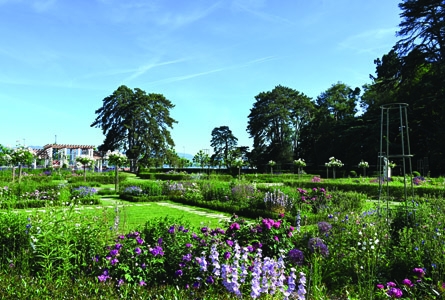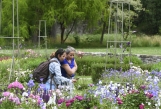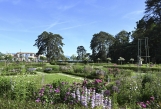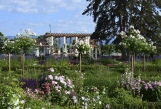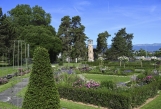The rose garden has been inaugurated. This new area is blossoming on the site of the historic rose garden in Parc La Grange. Maintained without any phytosanitary products, this vibrant contemporary garden is attractive throughout the year thanks to the wide variety of flowers and shrubs planted there.
Article associé
A rare event, the historic rose garden of Parc La Grange – one of the most illustrious symbols of green Geneva – is reborn in the form of a sustainable rose garden. A metallic pergola has been built above the garden. In a few years’ time, it will be entirely covered in climbing roses.
A 250-metre-long path has also been created from permeable material around the wooded edges of the garden, offering new viewpoints over the roses.
From chemical to natural
The new multi-coloured rose garden will be maintained without the use of any phytosanitary products. The roses have been chosen for the quality of their flowers, their resistance to disease and insects and their supposed capacity to adapt to climate change.
Together with the wide variety of plants on the site, these roses make an active contribution to the development of the park’s biodiversity. Now more authentic, the garden as a whole requires less maintenance than the old rose garden which was subject to treatment by chemicals which ultimately exhausted the soil. The new automatic watering system is more effective and the mulching will help limit evaporation until the plants cover the entire surface area.
Natural treatments are used to protect against illness and pests, thereby increasing the flowers’ resistance. Alfonso Gomez, Executive Councillor responsible for the Environment, is delighted “to be able to write a new chapter in the history of the La Grange rose garden, reconciling the beauty of the site with respect for small fauna, insects and the soil itself, without for all that losing sight of the heritage dimension and the attachment the public feels for it.”
A stunning variety
Some 400 rose bushes and almost 200 different varieties are planted in the garden. To extend the flowering period of the site, the roses are accompanied by more than 4,000 different flowers, perennials and bulbs. This vibrant combination enhances the impact of the garden as a whole and help revitalise this unique heritage site at the heart of one of Switzerland’s largest parks.
While the perennials currently have the largest visual impact, this impression will gradually change in favour of the roses which will reach a height of two metres in about five years’ time.
A spectacular change
The pageant will be particularly stunning at the heart of the octagonal garden inside four rooms whose walls of roses will offer visitors an unprecedented sensory experience. Each room is composed around a theme: the ladies room, with roses named after famous women (‘Ingrid Bergman’, ‘Jeanne d’Arc’, ‘Benoite Groult’); the old roses room (exuding romantic, rural charm in pastel shades); the modern roses room, where Chinese roses create a highly colourful atmosphere; and the wild roses room with heady scents.
Impressive restoration work
The Italian-style pergola (in stone, brick and concrete painted to look like wood) has been restored. It is bedecked in roses which are accompanied by a vine in tribute to the central sculpture of Bacchus. The flower-covered stone walls have been rebuilt as they were. Finally, the stone fountain (dating back before 1900) with its seashell basin is placed under the new pergola, as if in dialogue with the Italian pergola located diametrically opposite it on the other side of the octagon.
A historical reminder
One of the major attractions of Parc La Grange, the historic rose garden was built just after the Second World War by recently demobilised soldiers. Since then, the rose garden has delighted generations of residents and tourists from around the globe. Located at the bottom of the park, in accordance with the plans of the famous landscape architect Armand Auberson (creator of the flower clock in 1955), the rose garden stands proudly in the sun while protected from the wind. It is overlooked by a magnificent pergola erected in the 19th century by the estate owner, François-Edmond Favre, upon returning from Italy. Until 2015, the rose garden hosted the prestigious Geneva International Competition for New Roses. The renovation of the rose garden, its soil exhausted by decades of chemical treatment, began in 2020.
The new rose garden in figures
- 415 rose bushes (bushy, climbing, weeping, etc.)
- 181 different varieties of rose distributed to 4 rooms, each measuring 300 m²
- 4,400 plants accompanying the roses: perennials, bulbs, climbers, etc. (peonies, clematis, sages, carnations, bellflowers)
- 880 hedge bushes (yew, phillyrea, spindle and sculpted)
- Surface area of 2,230 m² for the octagon (50 m wide)
- A new path stretching 250 metres
- 1 new pergola measuring 21 m long, 4 m wide and 4.40 high.
- 10 benches and 9 chairs (wit armrests)
- 4 wooden benches from the original rose garden moved to the Villa La Grange
- 170 m³ of tarmacked ground stripped
- 1858: estimated date of construction of the Italian pergola and its terrace
- 1946: opening of the historic rose garden
- 2022: inauguration of the new rose garden
More information on the Parc la Grange rose garden page.
Contact
Anne Bonvin Bonfanti
Département des finances, de l'environnement et du logement
Conseillère de direction
Contact médias
5, rue de l'Hôtel-de-Ville
1204
Genève
Suisse
Article modifié le 10.06.2022 à 16:52

